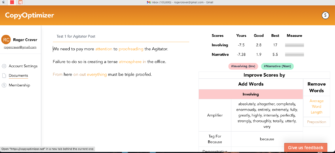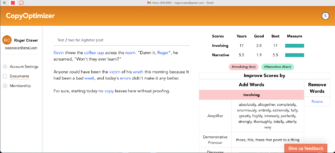Turning Vision Into Reality — Update on CopyOptimizer
Because it’s been a year since Kevin first unveiled CopyOptimizer™ this is an appropriate time for an update.
His dream was creation of an online tool to help everyone–including you and me– write better, more effective copy.
Anyhow, that vision has now turned into a reality. Lots of fundraisers are currently alpha testing it.
I’ve come to recognize its immense value—especially where email is concerned. By and large the quality of copy where email is concerned is downright dreadful. Not healthy, especially when more and more organizations are relying on that digital channel. I’ll come back to email in a moment.
First a brief chronology of what’s happened with CopyOptimizer™ over the past year.
- April 2020—Vision for CopyOptimizer™ announced in the post –What Makes for Good Fundraising Copy—where Kevin describes how linguists have “cracked the code” and explains why some copy works well, and some doesn’t.
- May, 2020– In We Don’t Write So Good most fundraising copy is found wanting…we report on early user testing…offer up some tips…and let Agitator readers know how they can sign up and participate in this early testing –free.
- May, 2020– In Your Story Well Told Kevin shares a hands-on example of how to use CopyOptimizer™ and announces that so far, the online tool predicts with 80% accuracy how a piece of copy will fare.
- July, 2020– Jerry Huntsinger’s classic 86 tutorials on Creating Fundraising Letters and Packages is put under the tool’s microscope in Getting Your Copy From Good to Great (or at least Better) to demonstrate how master copywriter Huntsinger would re-write a piece of copy and how Copy Optimizer™ does it.
- July, 2020- In The World’s Greatest Fundraising Letter Made Better we take one of history’s most successful letters and show how even a non-copywriter can improve it using Copy Optimizer™. You’ll see how this tool applies linguistic science to communication making all of us better by providing a more complete set of rules with measuring sticks.
- August, 2020- In The Case for More Abstraction in Fundraising illustrates why and how to tell a better story. Most fundraising copy (per Copy Optimizer’s work scoring up Narrative qualities) is, frankly, dreadful at storytelling. It’s all tell, no show. Part of showing is painting a picture and part of creating a more abstract goal and greater similarity is having that story start back in time and come forward – i.e. the redemptive arc. The post explains why we should spend more time thinking about the abstract goal and how you’ll create similarity between the reader and the beneficiary.
- August, 2020- Demonstrating one of the myriad uses for CopyOptimizer™ this post, Trump or Biden’s Convention Speeches: Which Was Better reviews a host of Presidential speeches and explains why some are successful and some not in terms of how they’re written.
- September, 2020- Realizing that the pandemic has placed heightened emphasis on digital communications we begin a series of multi-channel tests working with NextAfter as outlined in Seize This Digital Day.
- March, 2021- In Removing and Adding Words to Make Copy Better we take advice Jeff Brook offered up a decade ago and compared it to what a year’s testing with CopyOptimizer™ has shown. Some great do’s, don’t, words to kill and words to add advice.
TODAY—JUNE 7-8, 2021 brings me back to my current pet peeve: the lousy state of digital copy and why I believe CopyOptimizer™ can make a huge difference going forward.
First, a couple of stats gleaned from a post by the always on-target Claire Axelrad of Clarification. In a recent post Claire warned that we need to be paying far more attention to the digital dimension (and, btw, not forget the direct mail dimension either). Here’re some of those scary stats:
- On average American receive 605 emails each week and 16.8 pieces of mail every week.
- For every 36 emails you receive on average, you get 1 piece of postal mail in your mailbox.
- The average lifespan of an email is 17 seconds whereas direct mail’s average lifespan is 17 days.
And…I gotta say when I look at the quality of most emails, I’m surprised the lifespan is even 17 seconds. We have to do better.
So, knowing that CopyOptimizer™ works well on all forms of communication I decided to use it to create a sample email showing how the tool works.
For purposes of this illustration I prepared a fictitious internal email for the Agitator crew. I assumed that one of us had lost it when it comes to proofing errors on our blog (this is true) and that we had to improve (this is true) and I was going to put the word out regarding a change in our practices.
Here’s what I think would be a typical email using CopyOptimizer™ The screenshot below shows how it scored.

Next, I used the advice provided by CopyOptimizer™ and changed the original to a version that is far more likely to get attention and action.

Note the difference; not only in scores, but in effectiveness of the message. Now, imagine how this could help with your own internal or external communications.
If you’d like to participate in the final wave of free alpha testing, get in touch with Kevin. His email: kschulman@thedonorvoice.com
I promise he won’t throw that fictitious coffee cup. I’m not even sure he drinks coffee. I am absolutely sure he can help improve your communications and fundraising.
Roger



Thanks for this Roger. And thanks for mentioning my article. It’s so tricky to do effective copy writing. And there are so many communication channels today, where the best way to write for one isn’t necessarily the best for another. Who can possibly be an expert at all of them? Your new tool sounds like just what the doctor ordered. You’ve made me now want to go back and look at all these posts!
Hi Claire, thanks for the note. This tool is based on analyzing thousands of genres of communication, including written and verbal (that was transcribed) and informal (conversations, personal letters) to formal (books, press releases). Parts of speech are very predictive of communication type – if it walks like an academic journal and talks like an academic journal it is “felt” by the reader as one too. Too often fundraising copy feels just like this.
What we now also know is scoring well on our Dimensions of Involving and Narrative correlate with behavior – i.e. response. And this is independent of channel. Fortunately, there is lots of diagnostic guidance to improve the scores – add these parts of speech, remove these. Rescore. In our experience, the learning curve is steep so it takes very little time to raise the writing “floor”.
If you’d like a test drive in the alpha stage let me know.